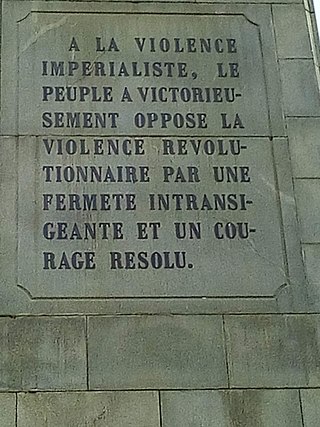
Guinea, officially the Republic of Guinea, is a coastal country in West Africa. It borders the Atlantic Ocean to the west, Guinea-Bissau to the northwest, Senegal to the north, Mali to the northeast, Cote d'Ivoire to the southeast, and Sierra Leone and Liberia to the south. It is sometimes referred to as Guinea-Conakry after its capital Conakry, to distinguish it from other territories in the eponymous region such as Guinea-Bissau and Equatorial Guinea. Guinea has a population of 13.5 million and an area of 245,857 square kilometres (94,926 sq mi).
The modern state of Guinea did not come into existence until 1958, but the history of the area stretches back well before European colonization. Its current boundaries were determined during the colonial period by the Berlin Conference (1884–1885) and the French, who ruled Guinea until 1958.

Politics of Guinea takes place in a framework of a presidential representative democratic republic, whereby the President of Guinea is both head of state and head of government of Guinea. Executive power is exercised by the government. Legislative power is vested in both the government and the National Assembly.

The foreign relations of Guinea, including those with its West African neighbors, have improved steadily since 1985.

Ahmed Sékou Touré was a Guinean political leader and African statesman who became the first president of Guinea, serving from 1958 until his death in 1984. Touré was among the primary Guinean nationalists involved in gaining independence of the country from France. He would later die in the United States in 1984.

Lansana Conté was a Guinean politician and military official who served as the second president of Guinea, from 3 April 1984 until his death on 22 December 2008. Conté came to power in the 1984 Guinean coup d'état.

Guinea elects on the national level a head of state—the president—and a legislature. The president is elected for a five-year term by the people through a two-round system. The National Assembly has 114 members, elected for five-year terms, 38 members in single-seat constituencies and 76 members by proportional representation.

Louis Lansana Beavogui was a Guinean politician. He was Prime Minister from 1972 to 1984 and was briefly interim President in 1984.
The Democratic Party of Guinea-African Democratic Rally is a political party in Guinea that dominated Guinean politics under a one-party state system. The party was founded as a branch of the African Democratic Rally (RDA) in June 1947. On 19 October 1958 the party severed its links with the RDA, other members of which supported a closer union with France. The party's leader, Ahmed Sékou Touré, became the country's first president. Two years later, he declared the PDG to be the sole legal party in the country. As president of the PDG, Touré was the only candidate for president of the republic, and as such was elected unopposed to four seven-year terms. Every five years, a single list of PDG candidates was returned to the National Assembly. After the death of Touré and a coup staged by Lansana Conté in 1984, the PDG was dissolved.
Mamadou Boye Bah was a Guinean political figure and economist and was one of the leading opponents of the presidents Sékou Touré and Lansana Conté.
Ibrahima Barry, popularly known as Barry III, was a Guinean politician. He was the leader of the political party Socialist Democracy of Guinea (DSG).

Ismaël Touré was a Guinean political figure and the half brother of President Ahmed Sékou Touré. He was the chief prosecutor at the notorious Camp Boiro.
Moussa Diakité was a Guinean politician during the presidency of Ahmed Sékou Touré. He was a member of the national Politburo. His wife, Tata Keïta, was half sister of the President's wife Andrée, and his son married the eldest daughter of Ismael Touré, the president's brother.
The Cabinet of the First Republic of Guinea was the governing body of Guinea from independence on 28 September 1958 until the death of President Ahmed Sékou Touré on 26 March 1984, followed by a bloodless coup by Colonel Lansana Conté on 3 April 1984. For much of that time, the country was run by a tight-knit inner group, many of them relatives of Sékou Touré, who became the primary beneficiaries of the regime.

Lansana Diané was a general and a minister in the cabinet of Ahmed Sekou Touré, President of Guinea during the First Republic (1958–1984). The military government that took power after Touré's death executed him in 1985.

The Monument du 22 Novembre 1970 is a monument in Conakry, Guinea that celebrates the defeat of the attempted coup led by Portuguese troops in 1970, named Operation Green Sea.
The following is a timeline of the history of the city of Conakry, Guinea.

The 1984 Guinean coup d'état was the bloodless military coup that took place in Guinea on 3 April 1984, led by Colonel Lansana Conté. It led to the deposition of Prime Minister Louis Lansana Beavogui, who had held the office since 1972, and had been serving as interim president since March, when longtime President Ahmed Sékou Touré died during an emergency heart operation at the Cleveland Clinic in the United States.

Guinea–Spain relations are the bilateral and diplomatic relations between these two countries. Guinea has an embassy in Madrid and honorary consulate in Barcelona, Las Palmas de Gran Canaria and Valencia. Spain has an embassy in Conakry.
Karim Keira was a Guinean politician, the former Minister of the first republic of Guinea under the regime of Ahmed Sékou Touré.
















